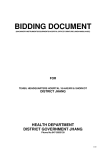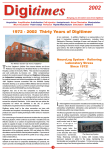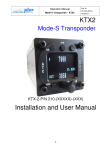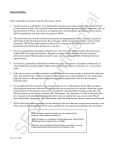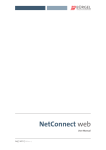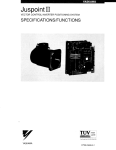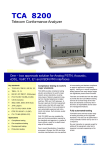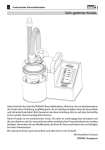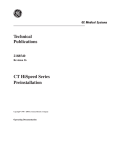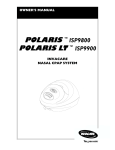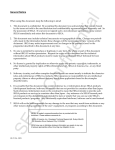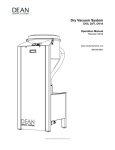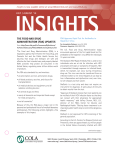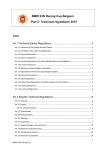Download Dynamic Frequency Selection (DFS)
Transcript
EMC EMC & Product Safety in Medical Devices Based on 3rd Edition of IEC60601-1. Radio Telecom Presented by Michael Brun Environmental Product Safety Group Manager & Customer Solutions Specialist [email protected] Product Safety International Approvals Agenda 9:30-10:45 - Overview of standard changes in IEC60601 family. • “State of the art in safety” for Medical Devices • Review of HAZARD, RISK, NORMAL CONDITION and SINGLE FAULT CONDITION concepts and their impact on compliance 11:00-12:15 – Zoom-in on EMC requirements. • • Test mode and essential performance Documentation requirements 12:30-13:15 - Lunch 13:30-14:45 - Zoom-in on other critical changes. • • Home Healthcare Changes in Technical Requirements 15:00-16:00- Review of requirements for International market access • International market access on example of Japan 16:00-16:30 - Questions and Answers. IEC 60601-X-XX Standards structure Collateral standards IEC 60601-1-XX General standard IEC 60601-1 Systems 60601-1-1 EMC 60601-1-2 Particular standards IEC 60601-2-XX IEC 60601-2-10 IEC 60601-2-XX IEC 60601-2-24 IEC 60601-2-XX Amendments Background The latest version of IEC 60601-1, its 3rd Edition “Medical electrical equipment - Part 1: General requirements for basic safety and essential performance”, was published in 2005. National standards for IEC 60601-1 3rd Edition were published in Europe, USA and Canada. Alignment of existing collateral standards IEC 60601-1-XX and most of particular standards IEC 60601-2-XX to 3rd Edition is completed. All new collateral and particular 60601-X-XX standards are aligned to 3rd Edition. NOTE: The main standard shall be used together with the collaterals and particulars aligned with this main standard. It may be a position of specific regulatory body to accept 2nd Edition of main standard with particular standard aligned with 3rd Edition. EN 60601-1-XX status information Collateral Title Standard EN 60601-1-1 EN 60601-1-2 EN 60601-1-3 EN 60601-1-4 EN 60601-1-6 Comment SAFETY REQUIREMENTS FOR MEDICAL incorporated (cl. 16) ELECTRICAL SYSTEMS ELECTROMAGNETIC COMPATIBILITY REQUIREMENTS AND TESTS GENERAL REQUIREMENTS FOR RADIATION PROTECTION IN DIAGNOSTIC X-RAY EQUIPMENT PROGRAMMABLE ELECTRICAL incorporated (cl. 14) MEDICAL SYSTEMS USABILITY EN 60601-1-8 GENERAL REQUIREMENTS, TESTS AND GUIDANCE FOR ALARM SYSTEMS IN MEDICAL ELECTRICAL EQUIPMENT AND MEDICAL ELECTRICAL SYSTEMS EN 60601-1-9 Requirements for environmentally conscious design not in OJ EN 60601-1-10 Requirements for the development of physiologic closed-loop controllers now! EN 60601-1-11 Home health care now! IEC 60601-1 3rd Edition: Why NOT to do it now? Technical: • Do not comply with 3rd Edition. • Particular standard exist only for 2rd Edition (e.g. Part 2-24: Particular requirements for the safety of infusion pumps and controllers IEC 60601-2-24:1998). Logistics: • Many markets still do not accept 3rd Edition • In most cases of particular standards, your product will become “clinical trial” for test methods. It has taken time for the industry and regulators to understand the new concepts. Major issue can arise which will take much time to get resolved. EN 60601-2-27: facilities and test methods ANSI-AAMI-EC13-2002 Annex C Need for this annex Many questions and vigorous discussions in and outside of committee meetings have arisen over the proper design, construction, and use of the test circuit prescribed in this standard for CMR and channel noise testing. It is the intent of this annex to resolve those questions and discussions, and, in so doing, foster greater testing consistency. IEC 60601-1 3rd Edition: Why to do it now? Technical reasons: • Product introduction is only expected in 2012 • Product does not comply with 2nd Edition. • Particular or collateral standards exist only for 3rd Edition, e.g. Home Healthcare products. http://www.uluniversity.us/Content/73/MediaLibrary/Home_Healthcare_Whitepaper.pdf Logistics: • General tendency for complicating existing requirements and adding new ones. • It may be easier now to get Certificate to 3rd Edition than in 1 year from now. • Product requires major modification in 2 years from now. It may be more cost effective to make file update. Re-Defining term “safety” for MD Certification agencies traditionally excluded high risk specialized equipment from scope of safety standards. Good example are products for use in military or aircraft applications. On other hand, for alarm system US and European standards have included performance requirements as part of “safety” for years. Manufacturers cannot get NRTL Listing without compliance with functional aspects. In Europe, harmonized functional standards exist. They are not part of CE Mark Directive, but insurances in Europe require compliance. 3rd Edition recycle term “safety” to make sure regulatory practice also cover MD critical performance aspects. Basic Safety 2nd Edition: Regulatory > Safety > Quality > Functionality 3rd Edition: Basic Safety and Essential Performance BASIC SAFETY is freedom from unacceptable RISK directly caused by physical HAZARDS when ME EQUIPMENT is used under NORMAL CONDITION and SINGLE FAULT CONDITION. ESSENTIAL PERFORMANCE ESSENTIAL PERFORMANCE (EP) is defined as performance necessary to achieve freedom from unacceptable RISK. Medical Devices (MD) are integral part of modern medical care. MD functionality and reliability also associated with quality of care. The quality of MD has been always part of regulation. Compliance with ISO 13485 is part of regulatory requirements for MD. HAZARD-HARM-RISK: what is the difference? HAZARD is any source of potential damage, harm or adverse health effects on something or someone under certain conditions at work. HAZARD can cause HARM • to individuals as health effects, or • to organizations as property or equipment losses. RISK is combination of the probability of occurrence of HARM and the severity of that HARM Traditional SAFETY Concepts 2nd Edition: Regulatory > Safety > Quality > Functionality SAFETY standard is set of requirements for construction and performance of Medical Device (MD) to ensure a sufficient degree of protection against SAFETY HAZARDS under NORMAL CONDITION and SINGLE FAULT CONDITION. But IEC60601-1-2:2001, 2nd Edition (EMC) already has term EP (taken from draft of IEC60601-1:2005). It allows a risk analysis to be used to determine the EP and safety of MEDICAL ELECTRICAL EQUIPMENT that must be examined during IMMUNITY testing. RISK MATRIX RISK is combination of the probability of occurrence of HARM and the severity of that HARM Probability Very Likely Likely Unlikely Remote Not relevant Severity Catastrophic Serious Moderate Minor High High High Medium High High Medium Low Medium Low No Risk Not relevant No Risk No Risk Negligible No Risk Medium Low Low Negligible Negligible No Risk No Risk No Risk No Risk No Risk Risk can be acceptable (e.g. green area) or unacceptable (red). Operating Conditions NORMAL CONDITION: condition in which all means provided for protection against SAFETY HAZARDS are intact. SINGLE FAULT CONDITION: Condition in which • a single means for protection against a SAFETY HAZARD is defective, or • a single external abnormal condition is present. Re-defining terms for Operating Conditions Faults are divided into 3 probability categories: • so remote that they can be ignored (e.g. REINFORCED INSULATION, TENSILE SAFETY FACTOR of 8X, COMPONENT WITH HIGH-INTEGRITY CHARACTERISTICS) • probable enough that they need to be considered, but improbable enough that they need only be considered one at a time (SINGLE FAULT) • so likely, so unpredictable or undetectable that they are considered to be a NORMAL CONDITION and need to be considered individually and collectively (“WORST CASE”). WORST CASE or SINGLE FAULT? Until now, two or more independent faults were considered so unlikely that only “single-fault” issues need be considered Where the probability of multiple faults is high enough (e.g., due to water spillage, inadequate design for ageing or corrosion), then two or more independent faults could occur with sufficient likelihood and can even be considered “WORST CASE” of NORMAL OPERATION. General rule is failure of anything less than one MOP (means of protection) is considered NORMAL OPERATION MOP The reliability of components that are used as MOP shall be assessed for the conditions of use in the product. They shall comply with one of the following : • • the applicable safety requirements of a relevant IEC, ISO or national standard; where there is no relevant IEC or ISO standard, the requirements of this standard have to be applied. Example: Gaskets and Seals shall comply to IEC60950-22, National Standards UL50E and UL 157 Testing for IP protection without gaskets if gaskets are not approved. Compliance, Standards, and Tolerable Risks Achieving regulatory approval for a given market does not necessarily guarantee that a product has tolerable safety risks. Product liability and safety laws exist in all developed countries. These laws vary in their application in different countries, due to their different legal traditions, and they may vary between different states within the U.S., and even between different counties within a state. NFPA99 NFPA99 definition of Wet Location includes all operating rooms. The current practice allows hospital to conduct risk assessment and for those operation rooms that are not wet they do not have to use GFCI or isolated power. NFPA99 Discussion minutes CE: Manufacturer responsibilities “Member States shall take all necessary steps to ensure that devices may be placed on the market and/or put into service only if they comply with the requirements laid down in this Directive ...” A product is “placed on the market” when it is made available for the first time. This is considered to take place when a product is transferred from the stage of manufacture with the intention of distribution or use on the Community market. “Putting into service" means the stage at which a device has been made available to the final user as being ready for use on the Community market for the first time for its intended purpose; Both terms refer to each individual product, not to a type of product, and whether it was manufactured as an individual unit or in series. CE: Placement on the market The product “placed on the market” or “put into service” must meet the current list of harmonized standards as the standards are updated and published under the European Journal. Once withdrawn, the standard will be removed from the EU list of harmonized standards and will no longer provide a presumption of conformity for the purposes of CE marking. Europe: Product Liability Directive The product should comply with the “state of the art in safety” on the day it was supplied or put into service. “State of the art” for European product liability means “the state of scientific and technical knowledge” at that time, which includes all published standards, even those not listed under a Directive. Complying with the regulatory standards for medical equipment and systems does not necessarily ensure compliance with the medical safety regulations, or with product liability and other safety laws. http://www.conformity.com/artman/publish/printer_feature247.shtml EP in 2nd Edition “Although this Standard is primarily concerned with safety, it contains some requirements regarding reliable operation where this is connected with safety.” Example: 42.3 APPLIED PARTS of equipment not intended to supply heat to a PATIENT shall not have surface temperatures exceeding 41°C. 2.9.12 During the test Thermal cut-outs shall not be de-activated and shall not operate EP is compliance with operational test requirements of IEC60601-1 2nd Edition, + IEC60601 collateral and particular standards. EP for EMC in 2nd Edition IEC60601-1-2:2001 (2nd Edition, mandatory since 2004) already has term ESSENTIAL PERFORMANCE taken from draft of IEC606011:2005. It allows a risk analysis to be used to determine the EP and safety of MD that must be examined during IMMUNITY testing, and whether testing according to this standard is required for non-medical electrical equipment that is combined with MEDICAL ELECTRICAL EQUIPMENT to form a SYSTEM. EP for products with alarm conditions If MD needs to notify the OPERATOR that a HAZARDOUS SITUATION can exist, then MD “shall include an ALARM SYSTEM complying with this collateral standard for that purpose.” The definition of ALARM CONDITION is “state of the ALARM SYSTEM when it has determined that a potential or actual HAZARD exists”. If you determined that such state exists, then EN / IEC 60601-1-8 is applicable. Alarm Signals … and if applicable, you need to generate visual signal as specified below. 6.3 Generation of ALARM SIGNALS 6.3.1 General Each ALARM CONDITION shall cause the generation of visual ALARM SIGNALS as specified in this collateral standard. If deemed necessary by RISK ASSESSMENT regarding the environment in which the ALARM SYSTEM is intended to be used, additional ALARM SIGNALS shall be generated. These additional ALARM SIGNALS may be auditory, verbal, vibratory or produced by other means. Please note the requirements of IEC 60601-1-8 standard relevant also to sound messages to patient (sound level, bandwidth and the like). Clinical Trials MDD specifically states that for devices intended for the clinical investigations, manufacturer should provide “a statement that the device in question conforms to the essential requirements apart from the aspects covered by the investigations and that, with regard to these aspects, every precaution has been taken to protect the health and safety of the patient.” Common interpretation is that the regulatory requirements should be checked in full (meaning compliance with EN60601-1 with all collateral standards). In practice, we have numerous cases when partial testing was accepted. Finding right balance Compliance with a standard offers a very good claim that the product was indeed safe, but … as the British Standards Institute states in the preamble to all its type test standards, “compliance with a British Standard does not of itself confer immunity from legal obligations”. 1. Use a Good Practice: GMP/GLP/GCP and the like. 2. Make your own Project Risk Assessment and Risk Mitigation Plan Conclusions, Part I For some MDs, compliance to 3rd Edition is now the only option to obtain regulatory approval! Various national regulators accept 3rd Edition, and have already announced withdraw date for 2nd Edition. For various product categories, safety assessment becomes state-of-the-art project with major time and cost implications. Always review your contract with test lab to understand SOW. It is not only Certificate of Compliance, but also Test Report and its content! Part II Electromagnetic compatibility (EMC) requirements for Medical Devices Presented by: Mr. Michael Nikishin, Hermon Laboratories EMC & Radio Group Manager Essential requirements under 93/42/EEC Medical Devices Directive (MDD) Annex I I. GENERAL REQUIREMENTS 1. The devices must be designed and manufactured in such a way that, when used under the conditions and for the purposes intended, they will not compromise the clinical condition or the safety of patients, users or other persons, provided that any risks which may be associated with their use constitute acceptable risks when weighed against the benefits to the patient and are compatible with a high level of protection of health and safety. 2. The solutions adopted by the manufacturer for the design and construction of the devices must conform to safety principles, taking account of the generally acknowledged state of the art. 3. The devices must achieve the performances intended by the manufacturer and be designed 4. The characteristics and performances referred to in Sections 1, 2 and 3 must not be adversely affected when the device is subjected to the stresses which can occur during normal conditions of use… II. REQUIREMENTS REGARDING DESIGN AND CONSTRUCTION 11. Protection against radiation 11.1. General: Devices shall be designed and manufactured in such a way that exposure of patients, users and other persons to radiation shall be reduced as far as possible compatible with the intended purpose, whilst not restricting the application of appropriate specified levels for therapeutic and diagnostic purposes. 11.2. Intended radiation 11.2.1. Where devices are designed to emit hazardous levels of radiation necessary for a specific medical purpose the benefit of which is considered to outweigh the risks inherent in the emission, it must be possible for the user to control the emissions. Such devices shall be designed and manufactured to ensure reproducibility and tolerance of relevant variable parameters. 11.2.2. Where devices are intended to emit potentially hazardous, visible and/or invisible radiation, they must be fitted, where practicable, with visual displays and/or audible warnings of such emissions. 11.3. Unintended radiation: Devices shall be designed and manufactured in such a way that exposure of patients, users and other persons to the emission of unintended, stray or scattered radiation is reduced as far as possible. 11.4. Instructions: The operating instructions for devices emitting radiation must give detailed information as to the nature of the emitted radiation, means of protecting the patient and the user and on ways of avoiding misuse and of eliminating the risks inherent in installation. IEC 60601-X-XX Standards structure Collateral standards IEC 60601-1-XX General standard IEC 60601-1 Systems 60601-1-1 EMC 60601-1-2 Particular standards IEC 60601-2-XX IEC 60601-2-10 IEC 60601-2-XX Amendments IEC 60601-2-24 IEC 60601-2-XX Some particular standards provide additional set up requirements and/or test limits for EMC ELECTROMAGNETIC COMPATIBILITY (Section 4.1.1) ME EQUIPMENT and ME SYSTEMS shall not emit ELECTROMAGNETIC DISTURBANCES that could affect radio services, other equipment or the ESSENTIAL PERFORMANCE of other ME EQUIPMENT and ME SYSTEMS. ME EQUIPMENT and ME SYSTEMS shall have adequate IMMUNITY to be able to provide its BASIC SAFETY and ESSENTIAL PERFORMANCE in the presence of ELECTROMAGNETIC DISTURBANCES. Consider compliance to exist if the requirements of this collateral standard are met. Emission limits Reference standard Test Procedure Port Test level Group 1 Radiated emissions CISPR 11 Enclosure Group 2 Group 1 Conducted emissions CISPR 11 AC power Group 2 Class A Class B Class A Class B Class A Class B Class A Class B Current Harmonics IEC 61000-3-2 AC power IEC 61000-3-2 Voltage fluctuations and flickers IEC 61000-3-3 AC power IEC 61000-3-3 Immunity test levels Reference standard Test Procedure Port ESD IEC 61000-4-2 Enclosure RI to RF fields IEC 61000-4-3 Enclosure Test level 0.15-80 MHz Contact 2, 4, 6 kV Air 2, 4, 8 kV AM 80% 1 kHz or AM 80% 2 Hz 3 or 10 V/m (Life support) AC power EFT IEC 61000-4-4 DC power* 2.0 kV 5 kHz 5/50 ns Other lines* Surge IEC 61000-4-5 1.0 kV Differential 0 Ω (2 Ω) 0.5/1.0 Common 10 Ω (12 Ω) 0.5/1.0/2.0 0.15-80 MHz AM 80% 1 kHz or AM 80% 2 Hz 3 or 10 VRMS (Life support) Enclosure 50/60 Hz 3 A/m >95% 10 ms <11.5VRMS 60% 100 ms 92 VRMS 30% 500 ms 161 VRMS >95% 5000 ms <11.5 VRMS AC power AC power CI to RF fields IEC 61000-4-6 DC power** Other lines** Magnetic fields Voltage dips and interruptions IEC 61000-4-8 IEC 61000-4-11 2.0 kV * - Applies only to ports which may be connected to cables longer than 3 meters ** - Applies only to ports which are connected to cables longer than 1 meters Test conditions Test name (Interpretation sheet SC 62A/Publication IEC 60601-1-2(2007), 3rd edition/I-SH 01) Test conditions Emissions Radiated emissions At any nominal power voltage/frequency (one is enough)*??? Conducted emissions At any nominal power voltage/frequency (one is enough)*??? Harmonic distortion At 230 V / 50 Hz only (100 VAC for Japan)* Voltage fluctuations and flicker At 230 V / 50 Hz only (100 VAC for Japan)* Immunity Electrostatic discharge (ESD) At any nominal power voltage/frequency (one is enough)* Radiated RF EM fields (RI) At any nominal power voltage/frequency (one is enough)* Electrical fast transients and bursts (EFT/B) At the minimum and maximum nominal voltages, any operating frequency* Surges At the minimum and maximum nominal voltages, at any operating frequency* Conducted RF EM fields (CI) At any nominal power voltage/frequency (one is enough)* Voltage dips, short interruptions and variations At the minimum and maximum nominal voltages, but at the minimum power frequency (50 Hz) only* Magnetic fields At all nominal power frequencies but at any power voltage (same frequency as applied field)* Non-medical electrical equipment (Section 4.1.2) Electrical equipment that is not ME EQUIPMENT and that is supplied as part of an ME SYSTEM is exempt from the EMC testing requirements of this collateral standard provided that the following conditions are met the electrical equipment that is not ME EQUIPMENT complies with applicable international EMC standards both the EMISSIONS and IMMUNITY of the electrical equipment that is not ME EQUIPMENT have been determined not to adversely affect the BASIC SAFETY or ESSENTIAL PERFORMANCE the EMISSIONS of the electrical equipment that is not ME EQUIPMENT have been determined not to cause the EMISSIONS of the ME SYSTEM to exceed applicable limits Check compliance by inspection of the documents Separation into groups Group 1 equipment contains all equipment in the scope of this standard which is not classified as group 2 equipment. Most types of ME EQUIPMENT and ME SYSTEMS generate or use RF energy only for their internal functioning and therefore belong to group 1. Group 2 equipment: contains equipment in which RF energy is intentionally generated and applied, in the form of electromagnetic radiation, inductive and/or capacitive coupling, to patients. Only a few EQUIPMENT apply RF energy to PATIENTS and are therefore members of group 2. Group 1 equipment Group 1 equipment contains all equipment in the scope of this standard which is not classified as group 2 equipment. Most types of ME EQUIPMENT and ME SYSTEMS generate or use RF energy only for their internal functioning and therefore belong to group 1. Electro- and magneto-cardiography EQUIPMENT Electro- and magneto-encephalography EQUIPMENT Electro- and magneto-myography EQUIPMENT EQUIPMENT intended to deliver energy to the PATIENT, but in a form that is other than RF electromagnetic Group 2 equipment Group 2 equipment: group 2 contains equipment in which RF energy is intentionally generated and applied, in the form of electromagnetic radiation, inductive and/or capacitive coupling, to patients. Only a few EQUIPMENT apply RF energy to PATIENTS and are therefore members of group 2. MRI Therapy EQUIPMENT Diathermy EQUIPMENT (short wave, ultra-short wave, microwave therapy EQUIPMENT) Hyperthermy EQUIPMENT High frequency surgical EQUIPMENT Class A and B installation environment Installation environment Standard Home/ Domestic Office/ Light industry Generic standards EN 61000-6-X Class B Medical standard EN 60601-1-2 Class B Class A The rest of standards EN55022, EN55011, EN300 386, EN61326, EN 301 489-X… Class B Class A Hospitals Industry NA Class A Class A Class A NA Class A Emissions test mode selection The main concern: Maximum power under the greatest activity The highest transmission power The highest data rate The highest power consumption Maximum cables configuration Maximum load conditions Equipment provided for the test shall be a representative of production model including the final layouts and final SW revisions Immunity test mode selection The main concern: Maximum gain (sensitivity) under the greatest activity The highest receiving gain The highest data rate All modules exersised frequently Maximum cables configuration The minimum sufficient receive power (minimum signal to noise specification) Equipment provided for the test shall be a representative of production model including the final layouts, SW may be modified to allow frequent monitoring of the EUT performance ESSENTIAL PERFORMANCE IEC 60601-1:2005 Section 4.3 The MANUFACTURER shall identify which functions of the ME EQUIPMENT and ME SYSTEMS are ESSENTIAL PERFORMANCE Where this standard specifies that ESSENTIAL PERFORMANCE is to be maintained following a particular test, these functions shall be used and compliance shall be checked by inspection, and if necessary, by functional test Where requirements of this standard refer to ESSENTIAL PERFORMANCE, that ESSENTIAL PERFORMANCE is determined by the MANUFACTURER in accordance with the MANUFACTURER’S policy for RISK acceptability Compliance is checked by inspection of the RISK MANAGEMENT FILE Section 5: Identification, marking and documents Marking on the outside of ME EQUIPMENT or ME EQUIPMENT parts (section 5.1) 5.1.1 Marking on the outside of ME EQUIPMENT or ME EQUIPMENT parts that include RF transmitters or that apply RF electromagnetic energy for diagnosis or treatment 5.1.2 Marking on the outside of ME EQUIPMENT or ME EQUIPMENT parts for which the connector testing exemption specified in 6.2.2.2 c) is used 5.1.3 Marking on the outside of ME EQUIPMENT and ME SYSTEMS that are specified for use only in a shielded location Section 5: Identification, marking and documents ACCOMPANYING DOCUMENTS (section 5.2) 5.2.2.1 Requirements applicable to all EQUIPMENT 5.2.2.2 Requirements applicable to EQUIPMENT other than those specified for use only in a shielded location 5.2.2.3 Requirements applicable to EQUIPMENT specified for use only in a shielded location 5.2.2.4 Requirements applicable to that intentionally apply RF energy for diagnosis or treatment 5.2.2.5 Requirements applicable to EQUIPMENT that intentionally receive RF electromagnetic energy for the purpose of their operation 5.2.2.6 Requirements applicable to EQUIPMENT that include RF transmitters 5.2.2.7 Requirements applicable to cables, transducers and other ACCESSORIES 5.2.2.8 Requirements applicable to LARGE, PERMANENTLY-INSTALLED EQUIPMENT 5.2.2.9 Requirements applicable to EQUIPMENT found to have no ESSENTIAL PERFORMANCE 5.2.2.10 Requirements applicable to TYPE A PROFESSIONAL EQUIPMENT Technical description (Section 5.2.2) A list of all cables and maximum lengths of cables (if applicable), transducers and other ACCESSORIES A warning that the use of ACCESSORIES, transducers and cables other than those specified may adversely effect EMC Guidance and MANUFACTURER’S declaration – ELECTROMAGNETIC EMISSIONS A warning that the ME EQUIPMENT or ME SYSTEM should not be used adjacent to or stacked with other equipment A justification for each COMPLIANCE LEVEL that is lower than the IEC 60601 TEST LEVEL Guidance and MANUFACTURER’S declaration – electromagnetic IMMUNITY The performance of the ME EQUIPMENT or ME SYSTEM that was determined to be ESSENTIAL PERFORMANCE Accompanying documents Instructions for use Technical description Guidance and manufacturer declaration- Electromagnetic emissions (life supporting and not life supporting equipment) Guidance and manufacturer declaration- Electromagnetic immunity (life supporting and not life supporting equipment) Recommended separation distances between portable and mobile RF communications equipment and the EQUIPMENT or SYSTEM (life supporting and not life supporting equipment) Guidance and manufacturer‟s declaration – electromagnetic EMISSIONS Guidance and manufacturer‟s declaration – electromagnetic IMMUNITY Guidance and manufacturer‟s declaration – RF fields IMMUNITY Recommended separation distances guide Part III (13:30-14:45) Zoom-in on critical changes. • Home Healthcare • Changes in Technical Requirements • Component selection for target market. • How to work with ISO 14971. Changes in scope of 3rd Edition The scope of IEC 60601-1 was significantly modified and expanded by deleting the phrase “under medical supervision” from the definition of medical electrical equipment, and adding “or compensation or alleviation of disease, injury or disability”. A collateral standard IEC 60601-1-XX becomes a normative part of the general standard on the date of its publication. Home Healthcare IEC 60601-1-11:2010 is the newest Collateral Standard to the 3rd Edition. Published in April as IEC and already a MUST for MDD. Title: Medical electrical equipment – Part 1-11: General requirements for basic safety and essential performance – Collateral Standard: Requirements for medical electrical equipment and medical electrical systems used in the home healthcare environment Good presentation by Dave Osborn, Philips Healthcare Sector Standards and Regulations Secretary, JWG6-Home Healthcare http://www.fda.gov/downloads/MedicalDevices/NewsEvents/WorkshopsConferences/UCM214274.pdf Home Healthcare Environment Any environment that is NOT a professional healthcare facility (where OPERATORS with medical training are continually available). NO PROTECTIVE EARTH connection only floating type applied parts permitted, unless the equipment is permanently installed by an electrician. Equipment intended for the home healthcare environment must be Class B with respect to emissions. The usability evaluation is required. ENCLOSURES must be at least IP21 (light rain proof). TRANSIT-OPERABLE, HANDHELD, and BODY-WORN equipment must be at least IP22. Do not seal battery compartments! International Approvals for Home Healthcare Before IEC 60601-1-11 manufacturers of healthcare equipment intended for use in homes have been required to comply with Europe: N. America: ROW: EN60335-1 with particular standards UL60601-1 or UL1431 IEC60335-1 or IEC 60601-1 After IEC 60601-1-11 which covers most home healthcare equipment, some devices may still be subject to the requirements of other standards. For example, UL1431 “Personal Hygiene and Health Care Appliances” covers household electric products for hygiene or other healthcare applications rated at 250 V or less. Products covered under this standard include hydromassage units, nebulizers, breast pumps, toothbrushes and contact lens disinfectors. Europe: N. America: ROW: EN60601-1 3rd Ed. With EN60601-1-11 ANSI60601-1 with IEC60601-1-11, or UL1431 IEC60335-1 or IEC 60601-1 2nd Ed International Approvals: CB scheme CB Scheme proved itself as most reputable. Also, governmental bodies act as NCBs in CB Scheme and as such have to accept CB test reports. Example: Importers to Israel of MAINS powered Home Healthcare equipment need to test sample at SII or provide CB or TUV (!) Certificate and Report to IEC60601-1 to get Import Permit. To qualify product for exemption from SII Import Permit for limited import (mostly for private use), importer needs to file request with Ministry of Industry, Trade and Labor and attach CB Certificate and Report. Changes in technical requirements Significant changes in technical requirements in body of the standard. • • More liberal view on isolation requirements for the Operator (IEC 60950-1) • Incorporates collateral standards for System (60601-1-1) and SW (60601-1-4) • Incorporates particular standard for total patient leakage current (60601-2-49) • Compliance requirements for Non-hazardous Lasers • More liberal view on temperatures on Applied Parts • Other changes Non-medical electrical equipment One of the most advertised technical changes in 3rd Edition is the relaxation of operator protection requirements, which makes for significant savings on the cost of medical equipment. For example, if a device or its components do not touch the patient, then that device or its components only need to meet the less stringent insulation and leakage requirements of IEC 60950-1 (ITE). What about EMC? Most probably, ITE device or its components do not comply with immunity requirements of MD. Normative references Always has been and still remains a problem! 2nd Ed: Particular standards may be synchronized with withdrawn collateral standard, like IEC60601-2-24:1996 (still in force) is based on IEC60601-1-2:1993. 3rd Ed: “The following referenced documents are indispensable for the application of this document. For dated references, only the edition cited applies. For undated references, the latest edition of the referenced document (including any amendments) applies.” IEC 60950-1:2001, Information technology equipment – Safety – Part 1: General requirements IEC 60825-1:1993, Safety of laser products – Part 1: Equipment classification, requirements and user's guide, with Amendment 1 (1997) and Amendment 2 (2001) Zoom in on IEC 60950-1:2001 2005: IEC60950-1 2nd Edition is published and can be used as alternative for superseded IEC60950-1 1st Edition for CB Scheme 2006: IEC60950-1 2nd Edition is adopted as EN60950-1:2006 2007: IEC60950-1 2nd Edition is adopted as UL/CSA60950-1:2007, and EN60950-1:2006 is Listed in OJ in 2007 (R&TTE) 2008: EN60950-1:2006 is Listed in OJ in 2008 (LVD) 2010: On December 1st EN/UL/CSA 60950-1:2001 and its amendment are withdrawn. IEC60950-1 1st Edition may still be used as a national standard by other countries also after 2010. But most component manufacturers will move after N. America and European Markets, and certify components to EN/UL/CSA 60950-1 2nd Edition. 11.3 Fire enclosures IEC 60601-1 2nd Edition has no requirements. UL 60601-1 has flammability requirements for parts of enclosure (V-2 for transportable equipment and V-0 for fixed equipment). In the 3rd Edition, the requirements are: • Internal parts: FV-1 for wire; FV-2 for connectors, printed circuit boards, insulation. • Enclosure: FV-2 for transportable & FV-1 for fixed equipment. • Bottom of fire enclosure rules are aligned with IEC 60950-1. 4.8 Components All components, including wiring, the failure of which could result in a hazard, shall be used in accordance with their specified ratings unless a specific exception is made in the standard or through the RISK MANAGEMENT PROCESS. As the end-use equipment manufacturer, you become responsible for ALL safety aspects of complete equipment and its installation, even those of incorporated certified components. Component approval The reliability of components that are used as means of protection shall be assessed for the conditions of use in the product. They shall comply with one of the following : • • the applicable safety requirements of a relevant IEC or ISO standard; where there is no relevant IEC or ISO standard, the requirements of this standard have to be applied. Component selection for CB approval. CB rules for components acceptance define 4 potential situations for component requirements: • There is an existing IEC standard for the component; • There is no IEC standard but there is a regional or national standard for the component; • No component requirements exists; • The end-product standard contains component requirements. http://www.iecee.org/Operational_documents/iecee_documents/od-cb2039_ed.1.0.pdf Component selection Introduction of concept “component approval” can create a gap between your expectations for coverage of component assessment, and actual testing performed. The same consideration is inherent to UL‟s Recognized Component Conditions of Acceptability (CoA). Components covered under UL Component Recognition Mark program are considered incomplete and are intended to be installed into another device, system or end-product. New-tech published our article on component selection in MAINS http://new-techonline.com/nt-mag/2010/05/%d7%91%d7%98%d7%99%d7%97%d7%95%d7%aa%d7%97%d7%a9%d7%9e%d7%9c%d7%99%d7%aa-%d7%91%d7%9e%d7%95%d7%a6%d7%a8/ Component approval considerations “Plug and play” approach to using components in your end-use product will most likely not work. Make sure to understand limitations of your components and prepare to cover them in end-use product investigation. Certification level, Conditions of acceptability, Installation instructions and user manual of components and sub-assemblies must be obtained and reviewed. Component selection for CB and NRTL approval. UL is not “worst case” for fuses, cables and power supplies any longer! Using components approved to National Standards only (like UL 60601-1 for power supplies) can prevent obtaining CB Report. CB and NRTL approval status for components and sub-assemblies should be provided ahead of investigation. If component approvals are adequate and acceptable, CB, NRTL and CE projects should take the same timeframe. Acceptance of construction or component is very much dependant on certification path. Watch latest developments in IEC component standards. Zoom-in on Laser Products There were no general requirements for most Radiation Hazards in 2nd Edition Normal procedure is to add IEC 60825-1 as amendment, but not to mention it anywhere in CE DoC or on NRTL Certificate 3rd Edition requires compliance with IEC 60825-1:1993 (superseded in 2005). New IEC60601-1-22 applies to laser equipment for either surgical, therapeutic, medical diagnostic, cosmetic, or veterinary applications, intended for its use on humans or animals, classified as a class 3B or class 4 laser product as defined by 3.22 and 3.23 in IEC 60825-1. Zoom-in on ESSENTIAL PERFORMANCE Performance requirements for specific MD defined by manufacturer based on RISK ASSESSMENT. + In IEC60601-1 3rd Edition, it is compliance with constructional and test requirements of main standard + IEC60601 collateral and particular standards Risk Assessment RISK ANALYSIS is systematic use of available information to identify HAZARDS and to estimate the RISK RISK EVALUATION is a judgment, on the basis of RISK ANALYSIS, of whether a RISK which is acceptable has been achieved in a given context based on the current values of society RISK ANALYSIS + RISK EVALUATION = RISK ASSESSMENT overall PROCESS comprising a RISK ANALYSIS and a RISK EVALUATION Risk Control and Management RISK CONTROL PROCESS through which decisions are reached and protective measures are implemented for reducing RISKS to, or maintaining RISKS within, specified levels Type or group of hazard Radiation hazards Origin Unit / Com Potential Mod ment consequences ule s Ionising radiation source Optical radiation (infrared, visible and ultraviolet), including laser Burn UV Lamp Probability Initial assessment Severity Risk level Risk Reduction N/A E-Not relevant E-Not relevant No Risk Damage to eyes and N/A skin Effects on N/A reproductive capability E-Not relevant E-Not relevant No Risk Genetic mutation Headache, insomnia, etc Burn N/A N/A E-Not relevant E-Not relevant No Risk E-Not relevant E-Not relevant No Risk N/A E-Not relevant E-Not relevant No Risk Damage to eyes and skin Long A-Very Likely C-Moderate High term exposur e N/A E-Not relevant E-Not relevant No Risk Effects on reproductive capability Genetic mutation Headache, insomnia, etc N/A N/A E-Not relevant E-Not relevant No Risk E-Not relevant E-Not relevant No Risk E-Not relevant E-Not relevant No Risk RISK MANAGEMENT systematic application of management policies, PROCEDURES and practices to the tasks of analyzing, evaluating and controlling RISK 4.2 Risk Management Process Requirement for the manufacturer of medical equipment and systems to have a formal risk management system that conforms to ISO 14971 There are more than 100 times where 3rd Edition requires to determine risk acceptability in applying a particular requirement. Test Laboratory shall verify compliance on a product basis and fill in the checklist in the Technical Report Form (TRF). Risk Management File The manufacturer shall compile documentation on known and foreseeable hazards associated with the MD in both normal and fault conditions. Reasonably foreseeable sequences or combinations of events that can result in a hazardous situation shall be considered and the resulting hazardous situation(s) shall be recorded. For each identified hazardous situation, the associated risk(s) shall be estimated using available information or data. For each identified hazardous situation, the manufacturer shall decide, using the criteria defined in the risk management plan, if risk reduction is required. The results of these activities shall be recorded in the risk management file. Working with Risk Management File There are more than 100 times where 3rd Edition requires to determine risk acceptability in applying a particular requirement. Test Laboratory shall verify compliance on a product basis and fill in the checklist in the Technical Report Form (TRF). ISO 14971 assessment Requirement for the manufacturer of medical equipment and systems to have a formal risk management system that conforms to ISO 14971 There are two options how the requirements of ISO 14971 should be evaluated • review of a manufacturer„s documentation, or • on-site assessment of a manufacturer's risk management process A certificate for ISO14971 is certainly a useful asset, but it does not exempt the safety test lab from having to verify compliance on a product basis and filling TRF. TRF contains some of the risk management requirements, but does not provide sufficient detail on the content . Technical report IEC/TR 62354 To synchronize testing procedures for medical electrical equipment based on 3rd Edition of IEC 60601-1 between various regulators and test labs, second edition of IEC/TR 62354 has been published in 2009. This technical report (a guidance, not a standard) primarily covers the third edition of IEC 60601-1, but not collateral and particular standards. ANSI/AAMI/IEC TIR62354:2009 - General testing procedures for medical electrical equipment, has been published a year ago (March 2010). To establish uniformity between test laboratories in assessment of ISO 14971 requirements, the Risk Management Task Force (RMTF) has been established. The main task is to detail the needed elements for “inspection of the risk management file” as called out in IEC 60601-1. Based on this work, it is anticipated that the TRF will be modified. Conclusions, Part III System approach has always been required, but 3rd Edition put more stress on it in form of risk management. You need to understand your product environment to make proper component selection and provide expected level of safety. Major aspects of essential performance and risk management are not synchronized between various regulators and test labs. TRF is published and has been in use for several years now, but does not provide sufficient detail on the content of essential performance and risk analysis. Part IV (15:00-16:00) Review of MD requirements for International market access JAPAN Information on the following slides is quoted from presentation “The Regulatory System for Importing Electrical /electronic Goods to Japan” by Mr. Kurt K. Heinz of NCB TÜV Rheinland Japan, presented on CB-Scheme Workshop in Tel-Aviv on 29 June 2010 Contents 1. Electrical Appliance and Material Safety Law (DENAN Law) 2. New Pharmaceutical Affairs Law (PAL) 83 Electrical Appliance and Material Safety Law (DENAN) Explanation for “Denki Yōhin” - Electrical Appliance and Materials In the DENAN, ”Denki Yōhin” is classified into two categories “Category A” and “Category B” Category A product : Need to obtain “Certificate of Conformity (CoC) by Registered Conformity Assessment Body (RCAB) = Registered by Japanese Government. Category B product : Not necessary to get CoC, but there is the obligation to conform to the Technical Requirements stipulated by the Ministerial Ordinance. Selfverification (confirmation) can be done by manufacturer. NOTE: There are many other products not being in scope of DENAN Law. And, even if subjecting to DENAN, there are also products being in scope of another regulation, e.g., therapeutic apparatus for households use, microwave oven, etc. 84 Product categories 85 Electrical products in Japanese market Products controlled by DENAN Products not controlled by DENAN Category A products 115 items Other electrical products which are not in scope of DENAN (but, may be in scope of other regulations, e.g., Radio Law, Pharmaceutical Affairs Law, etc.) Category B products 339 items 86 Power Supply Device with DC Output Category A AC Electrical Appliance DC Power Supply Unit 87 Extension Cord Set Category A Wiring Devices Multi Tap, Cord, Attachment Plug (respective part) 88 Hair Dryer Category B Electrical Motor Operated Appliance Electric Hair Dryer 89 Massage Chair Category A Electrical Motor Operated Appliance Electric Massager 90 DENAN Flowchart (B) DENAN Flowchart (D) Electrical Appliance and Material Safety Law (DENAN) Product Evaluation Category A product + Category B product RFI related Safety related (if required) Technical requirement Ordinance Clause 1 Technical requirement Ordinance Clause 1 Technical requirement Ordinance Clause 2 Technical requirement Ordinance Clause 2 Selection NOTE: Clause 1: Japanese original, requirements existing by each designated product Clause 2: based on international standards RFI test is part of Technical Requirements, but not for all. 94 Applicable Technical Requirements / Standards Category A product Manufacturer survey by RACB Audit / Registration Report upon request Notification of starting business Manufacturer Registered Conformity Assessment Body Registration by METI Request for CoC (Application) Issue of CoC Request for CoC (Application) Issue of CoC Request for CoC equivalent Issue of CoC (Application) equivalent Category A Products Legal action if necessary Notifying Supplier Importer Notification of starting business Category A Products Request for CoC equivalent (METI) Legal action if necessary Submit of CoC equivalent Overseas manufacturer (category A product) 97 Ministry of Economy, Trade and Industry New Pharmaceutical Affairs Law (PAL) 薬 事 法 98 Yaku Medicine Ji issue, topic Hō law Pharmaceutical Affairs Law Pharmaceutical Affairs Law (PAL, „Yakujihō‟) http://www.mhlw.go.jp/ Article 1: This law is intended to provide regulations required to ensure the quality, efficacy and safety of drugs, quasi-drugs, cosmetics and medical devices and to improve the public health and hygiene through necessary measures taken to promote the research and development of drugs and medical devices which are of particular importance to the medical practice. 99 New System of Medical Devices Classification s General Medical Devices – Class I, extremely low risk Potential risk is almost insignificant in case of malfunction or side effect. Examples: scalpel, X-Ray film (Designated) Controlled Medical Devices – Class II, low risk Having potential risk in case of malfunction or side effect. Examples: MRI, electronic sphygmomanometers, gastric catheters Specially Controlled Medical Devices – Class III / IV, middle/high risk Potential risk is significant in case of malfunction or side effect. Examples: dialyzer, pacemaker, stent 100 Product Certification 101 Marketing Authorization Holder (MAH) Resposible for distribution, quality of the product and manufacturing, and for vigillance system Products can be sold only to MAH(er) or Manufacturer License for Marketing Authorization Holders (Article 12) Classification by PAL Class I Class II Class III General MD Designated Controlled MD Specially Controlled MD Class IV Type of Marketing Authorization Holders No. 3 Type 102 No. 2 Type No. 1 Type License for Marketing Business of Medical Devices Marketing Authorization System 1. „License to Marketing Business‟ MAH Marketing Authorization Holder 2. ‘License (Registration) for Manufacture„ Production License (-Registration) 3. „Device Approval (MHLW) / Certification (RCB)„ Product Approval / Certification 104 Special Rules for Foreign Manufacturers A foreign manufacturer who intends to get product approval or product certificate needs Appointed/Designated MAH (D-MAH) in Japan D-MAHer may be: (1) Distributor (2) Third party (3) Company‟s subsidiary in Japan 105 License (Registration) for Manufacture „License for Manufacture‟ is required for all production sites (also abroad, with the exception of component suppliers). Inspection and registration is done by Prefecture and PMDA (Pharmaceuticals and Medical Devices Agency). These organizations reserve the right to do an Inspection/Audit on-site. Depending on the category of the license, the building and its equipment are subject to different requirements. Manufacture license categories: Type No. 1 „Animal Origin Devices‟ (PAL, Article 43) Type No. 2 „Sterile Devices‟ Type No. 3 „Other than No.1 and No.2 (Other general devices) Type No. 4 „License for Labeling, Packaging and storage 106 Accreditation of Foreign Manufacturer by PMDA A person intending to manufacture in foreign countries drugs or medical devices etc. that are imported to Japan may be accredited by the Minister as a foreign manufacturer. Accreditation is granted for each site according to the categories. Accreditation shall be renewed every 5 years. 107 Certification Process by Third Party Certification (RCB) Approval (Shōnin) of Medical Device by PMDA Certification (Ninshō) of Medical Device by RCB (Registered Certification Body) 108 Registration of the Production Site Application: Attachments: • Name of the manufacturer • Address • Registration category • Attachment for buildings and • Overview/technical drawings of the buildings and the equipment • Resume of the management representative • List of the manufactured products • Manufacturing process • Copies of existing licenses, approval or certificates equipment • Name & private address of the management representative • Name & address of the applicant (could be foreign manufacturer or MAH) 109 3 simple steps to access Japan 1. Appointment of the DMAHer in Japan 2. Accreditation of the production facility by PMDA 3. Application for product approval (via DMAH or directly) a) Class II: to RCB b) Class III, IV: to PMDA RCB/PMDA reviews the product application documents and checks the QMS(GMP) compliance (on-site Audit or Document Review of manufacturing facilities) 110 Supplemental explanation on Japanese regulations There are a number of products applicable to DENAN and “Pharmaceutical Affairs Law”. Examples: electric inhalators (heater or motor operated), household heating therapeutic appliances, electric massagers (motor-operated), electric bubble generators for bathtubs (motor-operated), magnetic therapeutic apparatus, household therapeutic ray apparatuses, household low frequency therapeutic apparatuses, etc. Transformers or DC power supply units which are used only for medical equipment and which are in the range specified by DENAN, are in the scope of DENAN but the “Pharmaceutical Affairs Law” does not apply. Detachable power cords are also treated in the same manner. Products subject to DENAN and with telecom or radio function, are also subject to the “Telecommunication Business Law” or “Radio Law” in addition to DENAN. Examples: receivers with modem function for telecommunication and/or radio communication function such as Bluetooth. 111 Q&A Thank You!

















































































































